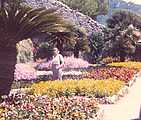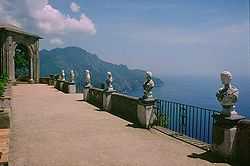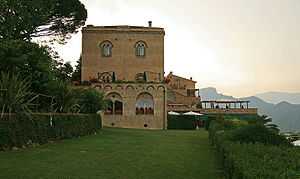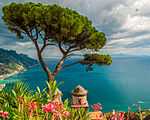Ravello
| Ravello | ||
|---|---|---|
| Comune | ||
| Comune di Ravello | ||
|
Amalfi Coast looking south from Ravello | ||
| ||
 Ravello Location of Ravello in Italy | ||
| Coordinates: 40°39′N 14°37′E / 40.650°N 14.617°E | ||
| Country | Italy | |
| Region | Campania | |
| Province | Salerno (SA) | |
| Frazioni | Sambuco, Torello, Castiglione, Marmorata, San Cosma, San Pietro alla Costa, Monte, Casa Bianca | |
| Government | ||
| • Mayor | Paolo Vuilleumier | |
| Area | ||
| • Total | 7 km2 (3 sq mi) | |
| Elevation | 365 m (1,198 ft) | |
| Population (1 December 2009) | ||
| • Total | 2,477 | |
| • Density | 350/km2 (920/sq mi) | |
| Demonym | Ravellesi | |
| Time zone | CET (UTC+1) | |
| • Summer (DST) | CEST (UTC+2) | |
| Postal code | 84010 | |
| Dialing code | 089 | |
| Patron saint | St. Pantaleon | |
| Saint day | July 27 | |
| Website | Official website | |
Ravello is a town and comune situated above the Amalfi Coast in the province of Salerno, Campania, southern Italy, with approximately 2,500 inhabitants. Its scenic beauty makes it a popular tourist destination, and earned it a listing as a UNESCO World Heritage Site in 1996.
The Amalfi Coast, or Costiera Amalfitana in Italian, is a stretch of coastline on the southern side of the Sorrentine Peninsula of Italy, extending from Positano in the west to Vietri sul Mare in the east
History
Ravello was founded in the 5th century as a shelter place against the barbarian invasions which marked the end of the Western Roman Empire. In the 9th century Ravello was an important town of the maritime republic of Amalfi, a producer of wool from its surrounding country that was dyed in the town and an important trading power in the Mediterranean between 839 and around 1200.
In 1086. at the request of the Norman count Roger Borsa, who wished to create a counterweight to powerful Amalfi, Pope Victor III made Ravello the seat of diocese immediately subject to the Holy See, with territory split off from that of the archdiocese of Amalfi. Early on, the bishops of Ravello all came from patrician families of the city, showing the church's municipalised character.
In the 12th century, Ravello had some 25,000 inhabitants, and it retains a disproportionate number of palazzi of the mercantile nobility, the Rufolo, d'Aflitto, Confalone and Della Marra. In 1137, after a first failed attack two years before, it was destroyed by the Republic of Pisa. After this, a demographic and economic decline set in, and much of its population moved to Naples and its surroundings.
On 31 July 1603 the Diocese of Ravello was merged aeque principaliter with the diocese of Scala. The Bishop of Scala, then Francesco Bennio, became bishop of Ravello - he and his successors remained titulars of both Ravello and Scala until 27 June 1818, when both dioceses were suppressed and merged into the archdiocese of Amalfi by Pope Pius VII's bull De utiliori, in the wake of his concordat with Ferdinand I.
Ravello was famed for its "patricians of Ravello", noble families that included the Acconciajoco, Alfano, Appencicario, Aufiero, Bove, Campanile, Cassitto, Castaldo, Citarella, Confalone, Coppola, Cortese, D'Afflitto, De Curtis, Dell'Isola, Della Marra, De Piccolellis, De Vito, Fenice, Foggia, Frezza, Fusco, Giusto, Grisone, Guerritore, Longo, Mansi, Marinelli, Muscettola, Panicola, Papice, Pironti, Rago, Rogadeo, Rovito, Rufolo, Russo, Rustici, Sasso, and Arcucci.
Main sights
Overview
- The Duomo (Cathedral) of Ravello: the central nave contains the "Pulpit of the Gospels", on the right of the central nave, created in 1272 by Nicolò di Bartolomeo from Foggia.[1]
- Villa Rufolo (1270), built by Nicola Rufolo, one of the richest Patricians of Ravello, on a ledge and it has become a famous attraction for thousands of visitors. The villa was mentioned by Giovanni Boccaccio in his Decameron and it is the place where Richard Wagner in 1880 was inspired for the stage design of his opera Parsifal.[2]
- Villa Cimbrone, famous for its "Terrace of the Infinite".[3]
- The church of San Giovanni del Toro (Saint John of the Bull) dating to before the year 1000. The church contains the Bove pulpit, dateable to 1200–1230, incorporated as mosaic fragments Raqqa bacini.
- The small church of Santa Maria a Gradillo (11th century). It has a basilica plan, with three apses.
- Sanctuary of Sts. Cosmas and Damian (14th century)
- Two famous gardens: Villa Cimbrone and Villa Rufolo.
Gallery
-

Ravello's Duomo
-

Villa Rufolo Gardens
-
Villa Rufolo (Bell house)
-
View of the sea from Villa Rufolo
-

Duomo square
-
Center of the town
-

Villa Cimbrone,Terrace of the Infinite
-

Villa Cimbrone
-
Oscar Nieyemer Auditorium
-

Vegetable garden of Villa Maria
-

View from garden of Villa Rufolo
-

Terace of Infinity in Villa Cimbrone
Culture
The town has served historically as a destination for artists, musicians, and writers, including Giovanni Boccaccio, Richard Wagner, Edvard Grieg, M. C. Escher,[4] Virginia Woolf, Greta Garbo, Gore Vidal, André Gide, Joan Mirò, Truman Capote, Tennessee Williams, Graham Greene, Jacqueline Kennedy, Leonard Bernstein and Sara Teasdale (who mentioned it in her prefatory dedication in Love Songs).
Every year in the summer months, the "Ravello Festival" takes place. It began in 1953 in honour of Richard Wagner, who signed the guestbook of his local hotel with the words "The magical garden of Klingsor is found" suggesting that it was in Ravello that the composer found the inspiration for his Parsifal.
There is an ancient legend, still recounted by tour guides in Salerno and Amalfi, that it was to Ravello, with its scenic view of the Mediterranean and the dramatic Amalfi coastline, that Satan transported Jesus during His second temptation to show the beauty of the world's kingdoms. (Luke 4: 5-8)
The 1953 film Beat the Devil, directed by John Huston and starring Humphrey Bogart, Jennifer Jones, and Gina Lollobrigida in her English language debut, was shot in Ravello.[5]
Transportation
![]() The nearest airport is Salerno-Pontecagnano Airport (QSR).
The nearest airport is Salerno-Pontecagnano Airport (QSR).
See also
|
References
- ↑ Duomo di Ravello
- ↑ Villa Rufolo
- ↑ Villa Cimbrone
- ↑ Emmer, Michele (2004). Matematica E Cultura 2004. Springer. p. 248. ISBN 978-88-470-0291-3.
- ↑ http://former.imdb.com/title/tt0046414/?ref_=fn_al_tt_1
External links
| Wikimedia Commons has media related to Ravello. |
- Official website Comune di Ravello official site (Italian only).
- Ravello Tourism Board The official tourist bureau provides a guide to Ravello, including its history and celebrities, accommodation and events.
- Ravello Travel Guide on Ravello with rich pages on the town's history and attractions.
- Ravello Concert Society Official website of the Chamber Music Festival.
- Ravello Festival Official website of the famous annual summer festival of music and arts, also popularly known as the "Wagner Festival".
| ||||||||||||||||||





